
E-mail: font@focusonnature.com
Phone: Toll-free in USA 1-888-721-3555
or 302/529-1876
 |
PO
Box 9021, Wilmington, DE 19809, USA E-mail: font@focusonnature.com Phone: Toll-free in USA 1-888-721-3555 or 302/529-1876 |
THE FOCUS ON NATURE TOUR IN ECUADOR
July 2013
"In
the Andes, on both the eastern and western slopes,
including the high paramo, where there are nearly no trees,
and the cloud forest and below where there are many"
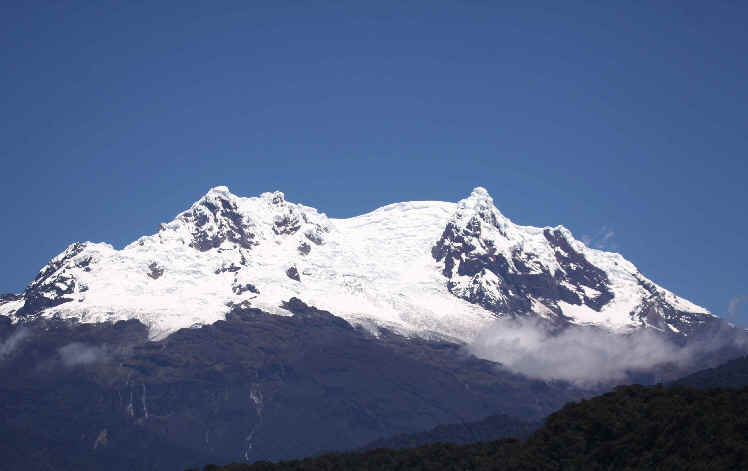
Above: the
volcano known as Antisana
Below: the tree-less habitat of the paramo
(Both photos by Marie Gardner during the April 2013 FONT Tour in Ecuador)
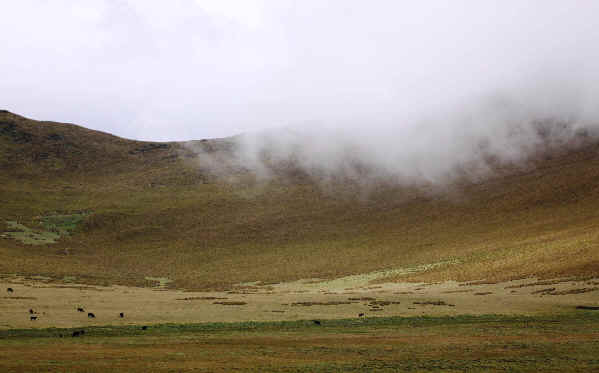
Links:
A Feature of Photos from the July 2013 Ecuador Tour
Birds during the FONT Ecuador Tour in July 2013
Lists & Photos of: Ecuador Birds South American Butterflies
Upcoming FONT Birding & Nature Tours in Ecuador
The following, relating to the FONT April
2013 Ecuador Tour, was
written by Armas Hill, the tour leader:
During our FONT Ecuador Tour
in April 2013, nearly all of time was spent very close to the Equator, near
0 degrees latitude.
It is after the Equator that Ecuador is named.
A few times, we crossed the Equator, just north of the Ecuadorian capital
city of Quito. The crossings are aptly called "mitad del mundo",
that is the "middle of the world". At two places right on the
Equator, there are monuments, one older and one newer. There we stood, with each
one of our feet in different hemispheres.
At no time or place during our tour, we were more than just a few kilometers
from the imaginary line where Earth is at its widest. And our miles from it of
course were
even less.
Yet, during our time in Ecuador, we saw so much, including the high paramo
above the treeline, and tropical forest filled with trees.
We did descend on the western slope of the Andes as low as 500 meters (or 1,650
feet) above sea level. There it was warm and moist as one might expect it to be
in the tropics.
But also in Ecuador near 0 degrees latitude, we saw snow. It was on the upper
reaches of a volcano called Antisana. With an altitude of 5,704 meters, or
18,714, is is the 4th highest of the many volcanoes in Ecuador.
Only a very few of them have recently been active. Antisana has not been since
1802.
During our April 2013 Ecuador Tour never far from the Equator, we saw many
birds, among as many as nearly 300 species.
Of course in Ecuador there are many species to be found. In the 4-part bird-list
in Ecuador in the FONT website, there are 1,632 species.
But even though Ecuador is a relatively small country, there are many
habitats and thus many different birds, from the seacoast to
high mountains, and from dry forest in the west to Amazonian rainforest in the
east. And birdlife is especially rich on the steep Andean slopes where
altitudinal differences are great.
In such an area during our tour, in the cloud forest and lower on the
west Andean slope, near Mindo, there is a significant diversity in
the birdlife and other nature.
The annual Audubon Society Christmas Bird Count in that region, the Mindo-Tandayapa
Count, has had a long run as the count with the most birds anywhere.
During the 2011-2012 season, that count tallied 432 species and 11,462
individual birds. Of those, 31 species were migrants from the north, and 5 of
them were wood-warblers.
In 2011-2012 however, another count in Ecuador surpassed long-standing #1 Mindo
Count, as during the newer Yanayacu Count, 492 species were found, but
"only" 5,578 individuals.
To give an idea of the birds during such an Ecuadorian Christmas Count, other
than the northern migrants, there were: 43 species of hummingbirds, 33
species of antbirds, 65 species of flycatchers, and 68 species of
tanagers.
Part of our April 2013 tour was in the what would be the Mindo-Tandayapa
Christmas Count circle, at Bellavista, a very good base for some very
good birding.
Relating to some of the bird species just mentioned, during our tour, at
Bellavista and elsewhere, we too saw, and enjoyed seeing, over 40 species of
hummingbirds.
During earlier FONT Ecuador Tours, in the 1990s, we birded in that lush
cloud-forested area west of Quito along what was the Nono-Mindo Road.
That road still exists, and is still great for birding, but nowadays the traffic
goes along another rather parallel road.
So, "no-no" it is for traffic, but "si-si" for some
wonderful birds, such as the Andean Cock-of-the Rock, the Plate-billed
Mountain-Toucan, and an impressive variety of tanagers.
And relating, again, to the hummingbirds, a notable difference between
now and what was when we were there two decades ago, is that now there are such
wonderful places with hummingbird feeders. They are the avian stars of
the show for both birders and non-birders. And for photographers too.
In days gone by, hummingbirds were found and seen of course, but not as
well as they are now.
And some other birds of note now seem to be seen "better than ever".
Of course, having a tremendous local birding guide, as we did with David Pinto,
helped considerably.
We saw forest birds so well that normally thought of as skulkers.
These included an assortment of antpittas and also an array of others,
such as an antthush, a tapaculo, and a wood quail. All of
these were seen so well, and due to the efforts of local guides at various
places that seemed, to us, to have a special rapport with these often-hidden
denizens of the forest.
The guides would put down some tidbits of food, sit quietly, and the birds would
come, while other times, they would call the birds, often by the nicknames, and
then sit and wait, or mimic the bird's call, and with patience, the birds came.
One guide did a duet with an Ocellated Tapaculo for over half an hour, as
we patiently stood or sat. The calling bird was on the other side of a valley,
but as it heard also "its name" (in Spanish of course), it ventured
closer and closer, until we saw it so nicely.
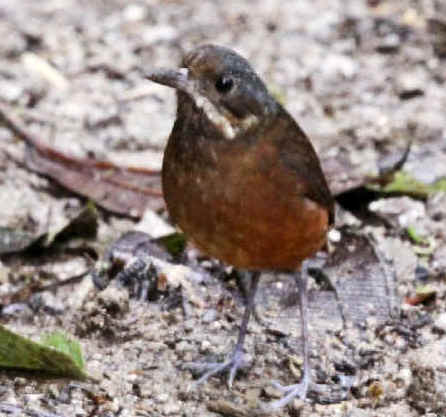
A Moustached Antpitta
photographed during
the FONT Ecuador Tour in April 2013
Antpittas so seen
included the Rufous, the Tawny, the Ochre-breasted, and the
Moustached.
The Moustached Antpitta, a vulnerable species as classified by Birdlife
International, was only confirmed to be in Ecuador in 1992. It is now said to be
rare, to at best locally fairly common.
Overhead in the sky, the Spot-fronted Swifts that we saw (due to Dave)
was a species first found in Ecuador, with two specimens, in 1989. (Although
1989 might seem "recent" to some of us, I'm not sure that David was
even born then.)
The Tanager Finch is a very rare and local bird in montane forest
undergrowth that we saw (due to Dave) during our tour. That handsome bird,
scarce in northwest Ecuador and southwest Colombia, has not been often over the
years by anyone, and never, previously, by us. We were glad to see it nicely.
The Colombian Screech Owl, classified by Birdlife International as a
"near-threatened species", was seen during our tour.
Also, we were taken to a newly-found site for Oilbirds by our driver,
Jorge, who was a good birder as well as a driver. Seeing them, as we did, one
morning, cliff-side in a cave, was a treat.
And we saw another bird by day, normally nocturnal, that is not often seen. In a
forest, on the east slope of the Andes, there was, above us on a snag, an Andean
Potoo. It is another species that has not been seen often over the years.
Our good base for fine birding on the eastern Andean slope was Guango.
Many nice birds for us, in addition to the Andean Potoo, were in that
area, but extraordinary there were the hummingbirds.
At this, yet another place, we enjoyed a good assortment of hummingbirds,
but first and foremost was probably what was for us one of the "best
birds" of the tour, the Sword-billed Hummingbird. We were treated to
tremendous looks at that bird, the only bird in the world whose bill is longer
than its body. Wow, what a bird!
Now, from "what a bird" to "what a sight", as also in the
"eastern sector" of our tour, we saw as many as 21 Andean
Condors at one place and time.
For Ecuador, that's a lot of Andeans Condors!
We went to a high-country reserve called Antisana (the same name as that
of the volcano at the beginning of this narrative).
We went there hoping to see a condor or two, and also to see some specialty
birds of that high area of Ecuador.
Included among the specialties we sought were the Black-faced Ibis, the Silvery
Grebe, and the Carunculated Caracara.
We saw them all, and other birds too such as Andean Lapwing, Andean Gull,
Andean Coot, and others without the "Andean adjective" include a
couple cinclodes, a canastero, a sierra-finch, a seedeater,
a siskin, and a pipit. Oops, the siskin was the Andean
Siskin!
Also, there was yet another hummingbird - the one that occurs at the highest
elevation of any in Ecuador - the Ecuadorian Hillstar.

Some Black-faced Ibises during
the FONT Ecuador Tour in April 2013.
As noted, this species is very rare in Ecuador.
The Black-faced Ibis is
not a rare bird in southern South America. In southern Chile and Argentina, it
is quite common. But in Ecuador it is very rare and local. Where we saw a flock
of them in flight, the bird is at the northernmost place in its range, and the
population there is well isolated from any other of the species.
The Silvery Grebe was on a lake in the reserve, and it was good to see
sprinkled in among the Andean Coots and various high-altitude ducks.
We had expected to see a few Carunculated Caracaras, but we saw many.
Often they were close to us by the road.
We also saw Variable Hawks. Another day, also high in the mountains, we
saw Black-chested Buzzard-Eagles.
But this particular day, at Antisana, as we had hoped to see "a few" Carunculated
Caracaras, we had also hoped to see "a couple", or maybe "a
few" Andean Condors.
Early, as we entered the area, we did see "a couple", in the area of a
high cliff-side nest, and then "a few" flying about above the crest of
a high ridge.
But, then as we were leaving the area, later in the day, we noticed, to our
left, on a rather distant sloping hillside, a GROUP of Andean Condors.
Apparently, they had found a meal.
We scanned, and we counted. There were 18 Andean Condors there, on that
hillside.
As we watched, three more came in, bringing the total to 21 Andean Condors
in view. Wow, what a sight!
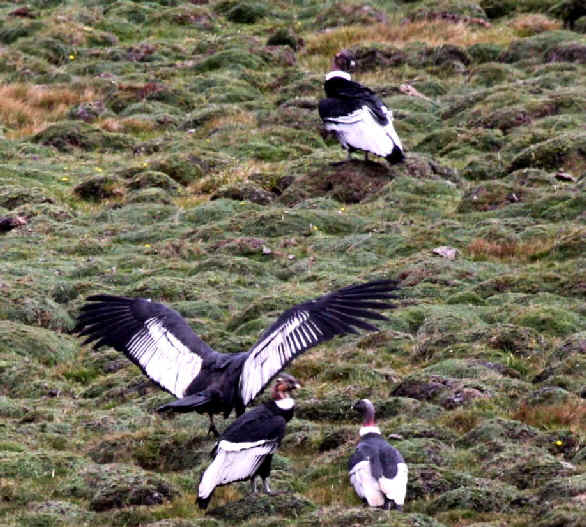
Above & below: some of the
Andean Condors
that we saw during our April 2013 Ecuador Tour.
We saw as many as 21 at once.
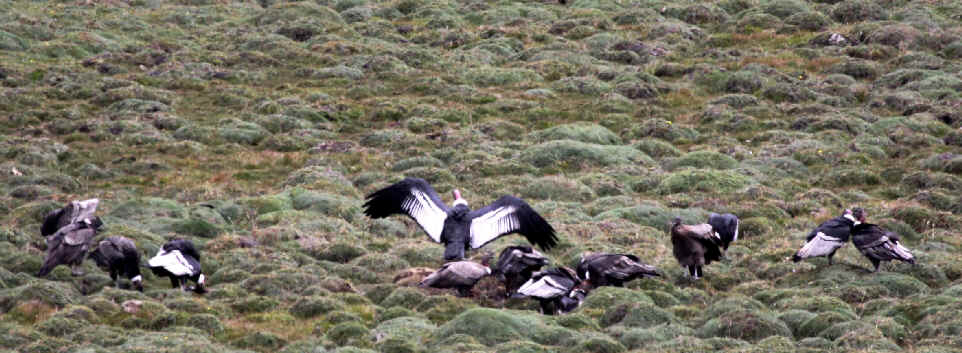
A number of the condors
that we saw were adults, but a number of them also were young birds.
We stayed for a while, but as some of the birds decided to go, it was quite
something to watch. Condors are big birds, about the biggest. And after they've
eaten, there are, apparently, heavier yet.
Just as loons need a long runway on the water to lift up into flight, so do
condors on the land.
They hop and jump as they move along in their effort to get into the sky. And
one after the other, with a certain space between them, the condors appeared as
jet planes in a line-up on a runway before ascending into the air.
We were told that the Andean Condor is a rare bird in Ecuador. What we
saw apparently was a rare sight. We were so fortunate.
Earlier, I mentioned that on the western side of the Andes, we descended to our
lowest elevation of the tour, at 1,650 feet above sea level.
That was at a place called Rio Silanche, one of two reserves we visited
in that region. The other was called Milpe.
At Rio Silanche, there's a tower that we could climb to be in the canopy.
From it, we saw some fine birds including a rare Plumbeous Hawk, an Orange-fronted
Barbet, Masked Tityra, and some tanagers and other birds.
At Milpe, more "in" the forest, birds ranged from the large Choco
Toucan to the small Choco Warbler.
We saw, in that nice reserve, some mixed flocks of interesting birds, but I'll
end, here, by referring to one of the two manakins that we enjoyed seeing
there at Milpe.
The two were the Golden-winged Manakin and the Club-winged Manakin.
Yes, both with names referring to their wings.
All manakins are nice to see, if one can see them. But the Club-winged
Manakin is exceptionally interesting.
In the May 2012 issue of the National Geographic magazine, there's an article
devoted entirely to the Club-winged Manakin, a little bird that live only
in the forest in parts of Ecuador and Colombia. The article is entitled "The
Virtuoso" and refers to the spectacular "song and dance act"
of the bird.
The article also refers to the study of it by the ornithologist, Kim Bostwick.
It notes that about half of the 40 or so species of manakins make music
as they execute maneuvers, by somehow moving their body
parts.
To go further in the article:
"Scientists knew that the wings (either golden, or clubbed, or otherwise)
were the source of the sound made by the manakins, but they didn't know
exactly how the process worked.
To crack the conundrum (in relation to the Club-winged Manakin), Bostwick
recorded the bird's movements on a video camera operating at a thousand frames
per second, more than 30 times as fast as a standard camcorder.
Viewing the video a few frames at a time led to a discovery.
The bird was knocking its wings together 107 times a second.
Examining the bird's secondary feathers in the lab, it could be seen that on
each wing there is a specialized feather with seven separate ridges.
The fifth feather rubs against the ridged feather in a plectrum-like action - in
music terminology, that's a plucking device, like a guitar pick - to
reach a frequency of an astonishing 1,500 cycles PER SECOND.
The result is a violin-like tone, somewhere between an F sharp and a G, more
than two octaves above middle C.
In the world, there are about 10,000 species of birds, but NO OTHER is known to
create a sound in this way - by so scraping body parts together."
During our April 2013 tour in Ecuador, we both saw and heard the Club-winged
Manakin do its display.
And so, apparently, of the approximately 300 species found during the tour, as
just noted, it's the only one to do what it does.
As big as the Andean Condor, and as small as the Club-winged Manakin,
and in between, so many of the birds during our tour were interesting - as well
as fun to see,
But birds themselves, even as good as they can be, do not alone make a
tour. It is also the people that do, and we did have a wonderful
time.
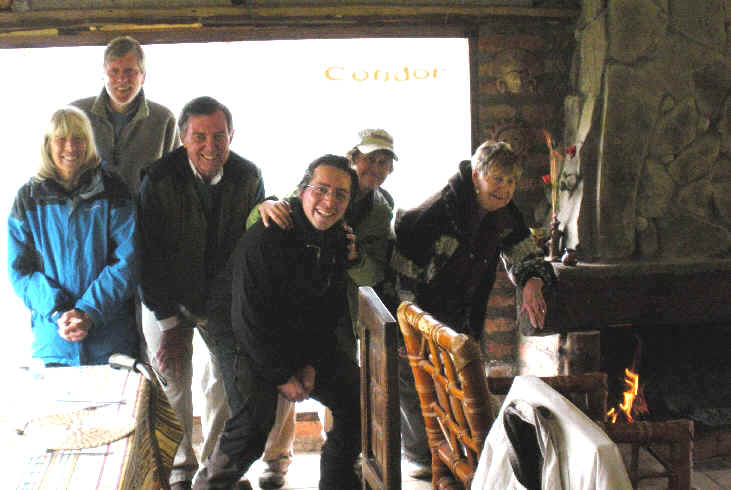
Our group at a
restaurant near where we saw the condors.